Embodied Symbols of the South Seas: Eastern Oceania
Article © 2010 Lars Krutak
Marquesas
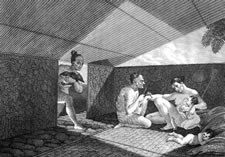 |
|
Marquesan tattooing scene, 1804.
|
The Marquesan archipelago consists of six inhabitable islands and other islets located approximately nine-hundred miles northeast of Tahiti. The island nation is divided into a northwestern group (Nukuhiva, 'Ua Pou, and 'Ua Huka) and a south-eastern group (Hiva Oa, Tahuata, and Fatuhiva) where dialectical differences and tattooing styles evolved since the region was settled by ancient mariners about 100 B.C.
The German explorer and ethnologist Karl von den Steinen, who visited the isles in 1891, listed over one-hundred and seventy individually named tattooing motifs which is remarkable since the tradition was "banned" by French officials approximately fifty years before that time.
Unlike other regions of Polynesia where descent and genealogical heritage from gods were the primary avenues for status and political control, the sociopolitical milieu of the Marquesas was more relaxed, devolved, and egalitarian. For example, rather than a rigid, stratified society controlled by ruling chiefs, the Marquesan world was sufficiently modified to the extent that property owners ('akatia), warriors (toa), political leaders, and even female shamans (etua) could also achieve great influence and power. In fact, on Fatuhiva - one of the most "democratic" of all the isles - a missionary that sought to know who was king was told: "You are king, I am king, we are all kings."
Due to the nature of indigenous political organization in the Marquesas, tattooing was not confined to certain ranks, classes, or the sexes. In fact, certain sacred chiefs of the highest rank were not tattooed at all. However, fine work was widely enjoyed by other chiefs, their warriors, and wealthy individuals who could afford to employ the best artists. Furthermore, only they could withstand the attendant expenses associated with feeding the tattoo artist and his assistants as well as other individuals (ka'ioi) who built the special tattooing house (oho'au) for the occasion.
Not surprisingly, these facts did not escape the attention of early writers who were fascinated by such customs, and today our knowledge of Marquesan tattooing is largely confined to observations revolving around the heavy marking of the male elite.
Marking the Opou
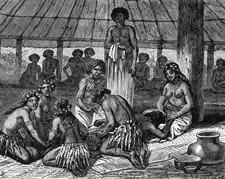 |
|
Marquesan tattooing scene, 1804.
|
In the case of a chief's first born son (opou), the chief prepared long in advance for paying and feeding his local tahuna. He raised pigs and had paper mulberry trees planted from which tapa cloth garments could be later made and gifted. Payment also took the form of ornaments, war clubs, and after European contact guns. While the tuhuna was paid generously for work on an opou, because nothing other than perfection was to be expected, no payment was asked of the ka'ioi or the chief's younger sons and daughters who provided food during the lengthy ritual. Instead, they were free to have designs punctured upon them gratis when the opportunity presented itself, usually when the opou was resting or recuperating from the effects of the painful operation.
Several days before the operation began, the father announced that the tattooing house was to be built. About one o'clock in the morning on the day of its construction, two great drums and two smaller ones were struck to announce the forthcoming tapu period and summon the ka'ioi. These individuals, usually from forty to eighty in number, immediately gathered and together proceeded, under the direction of the tuhuna, to raid the domicile of the opou's father. Here, they demolished his houses and those of his relatives, with the exception of the sleeping houses. They did this to seize material for the building of the oho'au and raw materials for making tapa. Enough pigs and other food, sufficient to last for the entire period of the operation, were also taken for the feeding of the ka'ioi, tuhuna, and all those who were to stay in the oho'au.
Before the tuhuna arrived at the newly constructed oho'au itself, the father of the opou had prepared the tattooing pigment (hinu). The preparation was a very tapu operation, and it is said that a virgin assisted him in this delicate work. The shells of the candlenut were heated so that they would open easily, and then the kernels were placed over a fire in a pocket of stones which allowed the smoke to ascend through a small passageway in order to collect on a smooth stone. Upon this stone a constant tapping was kept up while the soot collected to the depth of about an inch. The soot-covered stone was then placed on a banana leaf and left in the sun to dry, being kept this way until the tuhuna arrived for his work. Then the father mixed the soot with plain water in a small coconut shell and gave it to the artist.
The chief then proclaimed that all relationships with women were taboo to attending males during the period that was about to commence, and those men who enteredthe oho'au were compelled to hide if women were even sighted at a distance.
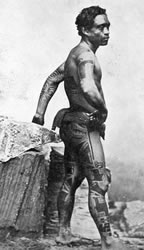 |
|
Warrior tattooing, 1900.
|
The tuhuna, or more appropriately the tuhuna patu tiki ("one who strikes or marks designs"), worked under the protection of a patron deity who's contagious power also enveloped those who came into contact with him while he worked. One early writer stated that the office of tuhuna was hereditary, and that each great family had its own stable of tattooists that were trained from generation to generation.
The tuhuna carried his instruments in a bamboo case that measured seven or eight inches long. He laid out his tools on a piece of tapa spread on the ground and prepared himself for work. These instruments were generally known as ta ("to strike"). Like in other parts of Polynesia, there was always an assortment of these tools and the combs varied in fineness depending on the grade of work (linework, fill) that was to be performed. The flat instruments for straight lines and gradual curves were of human bone, sometimes acquired from the corpses of sacrificed enemies. Each were about three inches long, flat and slightly wedge-shaped, and toothed or comb-like at the end. Tools for the smaller curves were made from the leg or wingbones of a booby or another species of unidentified bird.
The tuhuna was aided in his work by four or five assistants called ou'a ("pupils" or "disciples"). Like their counterparts elsewhere in Polynesia, each had a particular duty. Two or more ou'a held the arms and legs of the patient, while another stretched the skin to make a smooth surface upon which to work. Other ou'a fanned the flies from the bleeding wounds or filled-in the outlined designs.
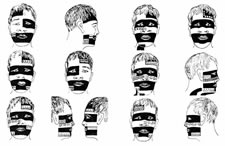 |
|
Male facial patterns, 1920.
|
The opou consulted the tuhuna regarding the choice of designs, although he was free to select his patterns. The tattooist outlined the designs upon the body with a piece of charcoal. The patient, clad only in a girdle, was simply laid on the floor. When a design had been sketched in charcoal upon the body, the tuhuna, or an assistant, held in his left hand the toothed hammer and a piece of tapa, with which by a dexterous twist of his hand he wiped away the blood as it flowed from the punctures made in the skin. As he worked, he kept a sufficient supply of pigment upon the teeth of the comb by dipping two fingers of his right hand into the ink and rubbing them upon the comb. While the tapping continued, the tuhuna chanted the following verse in rhythm to his strokes upon the opou's skin to console him:
It is struck, it is struck,
it is struck,
It is struck,
your design,
Tap-tapping your design,
The brother of the mother,
The sister of the mother,
My design.
At other times, chants were uttered to empower the agonizing patient, because it was said that a woman would not marry an unmarked man and a man was not respected even by children if he had not received a tattoo.
We tap, yes we tap you a little, yes?
Who knows who will come look at the ta-tu of this fellow?
A Beautiful maiden will come, yes!
To look at the ta-tu of this fellow, who knows?
The tattooing house itself was very tapu to outsiders and insiders alike. The tuhuna's assistants were especially tapu and could only eat special food. The opou and ka'ioi who were tattooed also observed food taboos, and for several days they were forbidden from eating pig meat and consuming kava beverages. These restrictions were intended to reduce the flowing of the blood and to diminish the inflammation that ensued from the wounds of the tattooing tool.
The duration of the operation depended largely upon the fortitude and health of the opou. A Nukuhiva man is reported to have been completely covered in three days; the legs and back of one man of Hiva Oa were done in seven days. But as a rule the designs were applied in a more leisurely fashion, a section of the body being covered at a sitting. In between each tattoo session were three day rest periods called "days of blood".
After each sitting, there were from eight to twelve days of local inflammation, followed by fever and sometimes swellings, which were at times fatal. The juice of the banana stem was used as an ointment to hasten healing. Sometimes, an emollient of hibiscus leaves or the healing fruits of the noni (Indian mulberry) were used to relieve the inflammation. Typically speaking, the entire process of tattooing lasted two weeks to four months.
As the tattooing drew to its necessary completion, the tahuna was paid, and when the tapu was lifted the sacred tattooing house was burned. All of those who participated were at last allowed to bathe and they traveled to the sea and then to a river. This accomplished, they covered themselves with fragrant ointment, which turned the skin yellow so that their bold patterns showed brilliantly. Meanwhile, relatives had prepared ornaments like tortoise shell crowns, girdles of tapa, feathered head ornaments, earrings, and other articles to be used in a public celebration honoring the newly marked. One very old account states that it was also at this time that a human victim was sacrificed and eaten.
A Warrior's Body
After an opou had recovered from his first encounter with the tattoo artist, he would continue to receive additional designs over his lifetime until his body was nearly black with tattooing. This pattern was equally characteristic of men of the warrior class who acquired fame and riches fighting for chiefs who controlled local valleys.
Each of the deeply carved volcanic valleys of the Marquesas was typically home to a single autonomous group composed of both chiefs (haka'iki) and commoners and known collectively as a mata'eina'a. Named after a specific ancestor, the mata'eina'a was ruled by one or more haka'iki whose political power and influence did not typically extend beyond the valley itself. In most cases, relationships between adjoining mata'eina'a were hostile, and the inhabitants of each valley were oftentimes engaged in a continuous, though small-scale, armed struggle with their neighbors. |
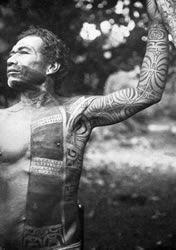
Warrior tattooing, 1920.
|
Because tribal unity was atypical of the region, the meanings and terms used to describe and define tattooing symbols varied from valley to valley, and even between individual tattoo masters themselves. However, there was a body of primary designs that were known regionally including symbols derived from nature and images of animals (lizards, turtles, sharks) or anthropomorphic humans (tiki) and derivative forms which played an important role in Marquesan mythology. Several of these motifs were also revered as protective spiritual guardians or genealogical symbols derived from deified ancestors who also offered some level of supernatural assistance to their living descendants. Of course, most of these tattoo designs were worn by warriors who literally covered themselves with a form of tattooed armor.
As in many indigenous cultures throughout the world, the identity and social standing of most men were largely determined by their achievements as warriors on the field of battle. Although war parties were dispatched by the haka'iki, the actual fighting was performed almost exclusively by the toa, a class of semiprofessional warriors second only to chiefs and shamans (tua) in power.
For the Marquesan warrior, tattoos were employed as a form of psychological warfare to inspire fear and awe in his enemies. After every battle, a man added fresh marks to his body to commemorate his achievements. Even if he was completely tattooed, another layer of marks were soon laid upon his skin.
| |
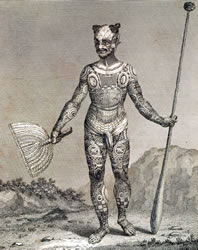 |
| |
Tattooed chief of Nukuhiva with mata komoe pattern tattooed on his thighs. |
Over the course of a lifetime, no part of the human canvas went unmarked. All regions of the body were tattooed, including the eyelids, inside of the nostrils, tongue, ear lobes, and the gums. The underarm patterns of a warrior made a fine showing when he lifted his war club to crush the skull of an opposing enemy. And indeed, any man who appeared to be lightly marked on the battlefield was certainly a primary target for a veteran toa.
Battle hardened men also possessed spirals over their eyes. Spirals on the cheeks and hips called kokoata indicated warrior chiefs, as did tiny pin-like marks placed on the inside of the left ankle. After a battle, the priest of a victorious army searched the slain for these ankle marks to determine whether a chief had been killed and a "great" battle fought. Other motifs were placed on the skin of warriors when an enemy had been killed or eaten.
Warriors also accentuated their menacing countenances with regalia including feathered headdresses and dense embellishments of human hair worn about the shoulders, waist, and limbs. As the toa ran into battle, this equipment undulated wildly, creating the impression of great ferocity and speed, while also disorienting the enemy. One writer reported:
I had seen several of their warriors since I had arrived, many of them highly ornamented with plumes, formed of the feathers of cocks and man-o-war [frigate] birds, and with the long tail feathers of the tropic bird; large tufts of hair were tied around their waists, their an[k]les, and their loins: a cloak, sometimes of red cloth, but more frequently of white paper [tapa] cloth... thrown not inelegantly over the shoulders, with large round or oval ornaments in their ears, formed of whales' teeth, ivory, or a kind of soft and light wood, whitened with chalk; from their neck suspended a whale's tooth, or highly polished shell, and round their loins several turns of the stronger kind of papercloth, the end of which hangs before in the manner of an apron: this with a black and highly polished spear of about twelve feet in length, or a club richly carved, and borne over the shoulders, constitutes the dress and equipment of a native warrior, whose body is highly and elegantly ornamented by tattooing, executed in a manner to excite our admiration.
| |
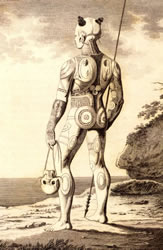 |
| |
Heavily tattooed Marquesan toa of Nukuhiva with head trophy, 1813. Note the mata komoe design in the center of his back. |
Many toa also carried the decorated skulls of their victims as evidence of their martial success. Sometimes they were adorned with natural materials to further humiliate their enemies, as one nineteenth-century writer noted: "These skulls decorated the houses of all the renowned warriors, who, in derision put on them pearl-shell eyes, a wooden nose, and pig's teeth." This powerful visual statement not only communicated an emphatic message of dread to a potential adversary, it also excited the imagination of early European writers who captured such poses for audiences back home.
Human heads, and especially their faces and eyes (mata), also held an important place in Marquesan art and genealogy (mata can also mean "ancestry"). For each of these specific body parts comprised the central motif in the artistic complex of the islands.
In Marquesan art, for example, objects decorated with motifs derived from the human face symbolize Tiki, a culture hero who, as "the ancestor of men," taught the Marquesan people most facets of their traditional culture. According to oral tradition, Tiki and his wife Hina-tu-na-one also gave rise to the first Marquesans, whose descendants became the founding ancestors of each mata'eina'a (literally, "face/eye people").
Down through the centuries, tiki images developed into artistic forms that commemorated the gods and other legendary figures from the mythological past. But tiki were also employed to represent the male generative force and human creativity, because the word can be used as a noun to mean "tattoo" or as verb "to sculpt or draw" a design. Thus, when placed on an object, or human body as a tattoo, tiki simultaneously refers to several opposing and related concepts: the realm of ao, creativity, fertility, and life; andthe realm of po, death, and the spiritual/divine world.
| |
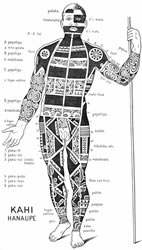 |
| |
Schematic view of a tattooed Marquesan warrior. |
Of course, in Marquesan sculptural traditions tiki generally refers to all statuary rendered in anthropomorphic form. These human images typically represented a diversity of supernatural beings, or etua, including the gods and goddesses who created the universe to patron deities and especially deified ancestors. All of these entities possessed great mana.
In this connection, it should noted that tiki were metaphorically and stylistically linked to a pair of important warrior tattoo designs, mata komoe and ipu, that were, in all likelihood, believed to have harnessed ancestral power. These exceedingly common patterns were, like tiki, comprised of a pair of eyes and other facial features like the nose and mouth rendered naturalistically or in nonfigurative form.
One of the earliest foreign visitors to have recorded one of these designs was the Russian explorer Langsdorff who landed in the in Marquesas in 1804. He depicted the head trophies of the toa as well as their tattooing designs like the mata komoe motif that was centered on the backs of men and many other parts of the body. This tiki-liketattooing pattern is said to have been the most popular design amongst the toa, and is believed to have been derived from a legendary chief named Komoe and what von den Steinen called the "skull face" or "face of Komoe." Apart from marking the bodies of warriors, chiefs, and other notable personages, this motif was also carved as rock art: especially at or near the burial grounds of chiefs and priests.
Another tiki-like tattoo motif called ipu resembles the mata komoe design, but it is slightly more abstract. According to art historian Carol Ivory, the word ipu symbolizes a container or vessel and when combined with other terms its meaning changes to "protective shield or covering." When Langsdorff visited the Marquesas he reported that ipu appeared only on the thighs and underside of the arms. In battle, these areas of the body were quite vulnerable to enemy weaponry especially when a toa hurled a spear or raised his club or slingshot. Placing ipu tattoos at these locations of the body suggests that they may have offered some form of perceived psychological, spiritual, or ancestral protection to the wearer.
If this hypothesis is correct, the process of tattooing would seem to have sealed the body's surfaces with the eyes and faces of gods and ancestors that in turn empowered the possessor. As vision, genealogy, and power were closely identified in the Marquesas, a proliferation of eyes conveyed diminished vulnerability while also providing the warrior with an additional skin or shell. At the same time, this tattooed armor diminished both the body's susceptibility to tapu substances, like blood spilled on the battlefield, and an opponent's mana that could be lethal. |
|
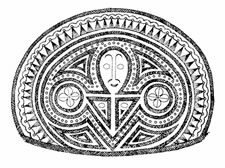
Lapita face design imprinted on a pottery vessel,
ca. 1000 B.C.
This motif may have been the ancestral form from
which tiki-derived
tattoos
like the mata komoe found their inspiration.
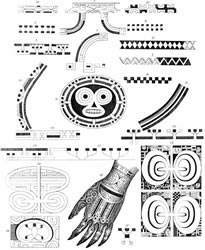
Langsdorff's illustration of the mata komoe pattern (#9) and ipu designs (#17)
|
Life After Death
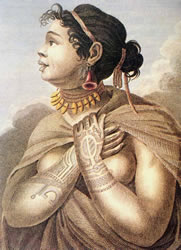 |
|
Tattooing of a Marquesan woman, 1804. |
Over the course of a warrior's lifetime in the Marquesas, a man's epidermis was covered with layer upon layer of sacred protection until his body was black with designs. At death, however, these mana infused markings were erased, so that the man could be reborn in a perfectly pure coat of godly skin. This ritual practice was significant, because it was an essential element in the making and unmaking of men, and the cosmic interplay between the ao and the po.
The Marquesans believed in an afterworld divided into a melancholy realm occupied by past servants and common people, and an Eden ruled by the goddess Oupu into which the spirits of chiefs and other persons of status might be admitted. However, Oupu forbade tattooing in her abode, and particularly violent deities lingered here to punish those people who possessed the tabooed body modifications.
As a consequence of this perceived reality in the land of the dead, the wife or relatives of a tattooed individual were compelled to carefully rub away the corpse's tattooed skin over a period of months. After which time the body was removed to sacred ground, from which the spirit was later understood to depart by canoe to the underworld.
Polynesians, as noted above, associated the divine realm with the concept of po or what could be called the "dark place". It is also from this tapu location that newborns emerged into the light of the living, and as they matured into adulthood they participated in various rituals of deconsecration and protection (e.g., tattooing) that rendered them less contagious (tapu) and less vulnerable.
But when a person left the ao and moved back to the world of night after death, their tattooed wrappings were removed and their sanctity enhanced, so that they could be assimilated again to their original condition in the po. Just as tuhuna patu tiki created a person in the world of light through the application of artificial skins, Marquesan women created a person for the next world by removing those skins; stripping away the visual armor from which the person had been constructed. And perhaps for this reason women were tattooed on their hands at a very early age to render the tapu state of the dead much less dangerous. |
 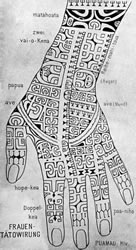
Hand tattoos of a Marquesan woman, ca. 1920.
|
Next Page | 1 | 2 | 3 | 4 | 5 | 6 | 7 | 8 |
Museum photo gallery of the images
on this page may be seen here. |













